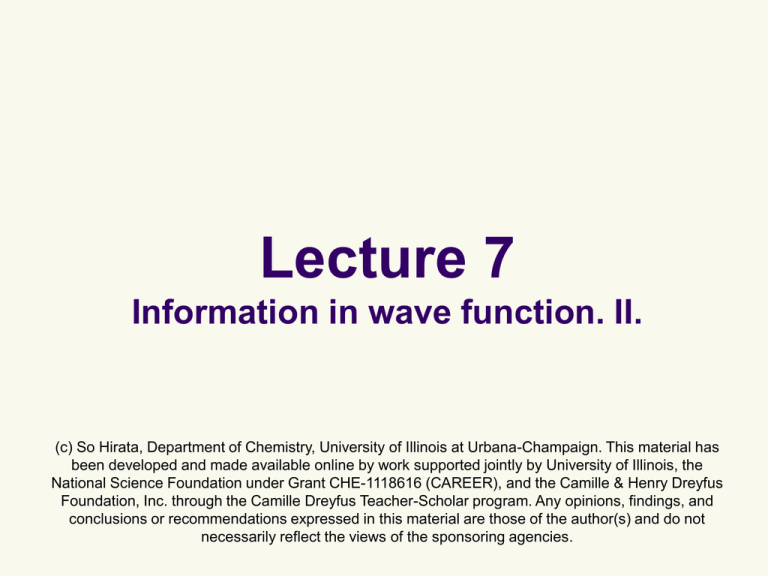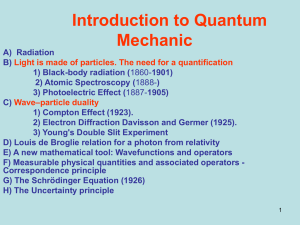CHM 4412 Physical Chemistry II - University of Illinois at Urbana
advertisement

Lecture 7
Information in wave function. II.
(c) So Hirata, Department of Chemistry, University of Illinois at Urbana-Champaign. This material has
been developed and made available online by work supported jointly by University of Illinois, the
National Science Foundation under Grant CHE-1118616 (CAREER), and the Camille & Henry Dreyfus
Foundation, Inc. through the Camille Dreyfus Teacher-Scholar program. Any opinions, findings, and
conclusions or recommendations expressed in this material are those of the author(s) and do not
necessarily reflect the views of the sponsoring agencies.
Information
in wave function
Properties other than energy are also
contained in wave functions and can be
extracted by solving eigenvalue equations.
We learn a number of important
mathematical concepts: (a) Hermitian
operator; (b) orthogonality of eigenfunctions;
(c) completeness of eigenfunctions; (d)
superposition of wave functions; (e)
expectation value; (f) commutability of
operators; (g) the uncertainty principle, etc.
What we have learned
in the previous lecture
If a particle is in the state Ψa, it has a welldefined energy E; if it is in Ψb, then it has the
position x; if it is in Ψc, it has the momentum
px.
Hˆ a E a
xˆ b x b
pˆ x c p x c
These three wave
functions are
eigenfunctions of three
different operators and
are generally different.
Next questions
What is the energy of a state that it not the
solution of the Schrödinger equation (for
energy)? What is the position and momentum
of a state that is not the solutions of the
Schrödinger-like eigenvalue equations for
position and momentum?
Can a state be the simultaneous
eigenfunction of two or more observable
operators?
Superpositions and
expectation values
To answer these, we use completeness and
orthogonality of eigenfunctions of Hermitian
operators.
We expand the normalized wave function Ψ
as a linear combination of eigenfunctions.
ˆ
HY
= En Y n
n
Y = c1Y1 + c2Y 2 + c3Y 3 +
(completeness)
*
Y
ò 3Y dt = c3 (orthogonality)
Superpositions and
expectation values
When we make a measurement of energy of
the particle in this “mixed” state, we do NOT
obtain a mixed energy that is a linear
combination of energies En. Such a theory
would contradict the quantization of energy.
Y = c1Y1 + c2Y 2 + c3Y3 +
E = c1 E1 + c2 E2 + c3 E3 +
.
.
Superpositions and
expectation values
Instead, we obtain one of the allowed
energy eigenvalues {En}. The probability
of obtaining En is |cn|2.
Y = c1Y1 + c2Y 2 + c3Y3 +
.
This is consistent with the Born interpretation
of a wave function – something to do with the
probability.
This principle of superposition also applies
to properties other than energy.
Superpositions and
the Born interpretation
Dirac’s delta function
Y ( x ) = cx d ( x - x1 ) + cx d ( x - x2 ) + cx d ( x - x3 ) +
1
2
3
cx = Y(xn )dx
n
.
Superpositions and
expectation values
What is the average energy (or any other
property) value of a wave function Ψ ?
We obtain En at the probability of |cn|2.
Therefore, the expectation value of energy
would be:
2
2
2
E º c1 E1 + c2 E2 + c3 E3 +
ˆ dt
= ò Y HY
*
In general,
Justification will be given next
ˆ dt
W = ò Y* WY
Superpositions and
expectation values
Quantum mechanics as a raffle draw.
2
Pure state (eigenstate)
Every time we draw (measure
the property), we get the same
result (2) because the bag
contains only one ball.
1
Mixed state (superposition)
We get either 1, 2, 3, or 4 at equal
probability. Expectation value is 2.5.
This does NOT mean that we draw a
ball labeled 2.5!
2
3
4
Justification
For a pure state, the wave function is an
eigenfunction of the operator Ω:
ˆ dt = Y*wY dt = w Y* Y dt = w
W = ò Y* WY
ò
ò
For a mixed state, the wave function is a
superposition of two or more eigenfunctions.
(
) (
)
ˆ ( c Y ) dt + ( c Y ) W
ˆ ( c Y ) dt
= ò (c Y )W
ò
ˆ ( c Y ) dt + ( c Y ) W
ˆ ( c Y ) dt
+ ò (c Y )W
ò
ˆ d t = c *Y * + c * Y * W
W = ò Y * WY
ò 1 1 2 2 ˆ c1 Y1 + c2 Y 2 dt
2
*
1
*
1
*
2
*
2
1
1
2
1
*
2
*
2
1
*
1
*
1
2
2
2
2
These are zero
by orthogonality
= c1 w 1 + c2 w 2 (matches the definition of expectation value)
The uncertainty principle
Can a state be the simultaneous
eigenfunction of two or more observable
operators?
The answer is yes and no.
Certain two observables cannot have a
simultaneous eigenfunction and thus cannot
be determined exactly simultaneously. The
uncertainty principle is operative for the two
observables or operators.
Non-commutable operators
For two operators to share the same
eigenfunction,
Aˆ a , Bˆ b
Acting B from the left on the first equation
and acting A from the left on the second
equation, we have
Bˆ Aˆ ba , Aˆ Bˆ ab
Non-commutable operators
When two operators share the same
eigenfunctions, then Aˆ Bˆ Bˆ Aˆ , namely, the
two operators commute.
The composite operations of the two do not
depend on the order of the two operations.
In other words, the order of measurements of
the two observables does not alter the results
of measurements.
Order of operations
2
1
1
2
Non-commutable operators
Many quantum-mechanical operators do not
commute. For example, position and
momentum operators do not commute.
æ
¶ö
xˆpˆ x = x ç -i
¶x ÷ø
è
æ
¶ö
pˆ x xˆ = ç -i
x
÷
¶x ø
è
= -i
æ
¶ö
+ x ç -i
¶x ÷ø
è
Both px and x are operators
acting on a function on the right.
px can act on x or the function.
Non-commutable operators
x and px are non-commutable operators.
Generally, we can express their
commutability using the commutator [A,B] =
AB – BA:
éë xˆ , pˆ x ùû = i (xˆ and pˆ x do NOT commute)
é
ù
¶
ˆ
ˆ
t
,i
=
-i
(
t
and energy do NOT commute)
ê
ú
¶t û
ë
éë xˆ , yˆ ùû = 0 (xˆ and yˆ commute)
The uncertainty principle
When two operators do not commute:
Aˆ , Bˆ
A and B correspond to
complementary observables, which
cannot be determined simultaneously
and exactly.
The errors in the observables ΔA and
ΔB cannot be simultaneously zero.
Werner Heisenberg
Image source: Bundesarchiv, Bild183-R57262 / CC-BY-SA
A B
1
2
The uncertainty principle
Position and momentum:
Dx × Dpx ³ 12
Note 1: x and py commute! The uncertainty is
in determining x and px or y and py, etc.
Note 2: ħ has the unit of Js = Nms = kgm2/s.
So does xpx.
Note 3: when Δx = 0, Δpx = ∞ and vice versa.
Time and energy:
Dt × DE ³ 12
Note 4: tE also has the unit of Js.
The uncertainty principle
The fact that the product of errors is on the order
of ħ = 6.63 ×10–34 / 2π Js is why we do not
notice this at the macroscopic scale.
The uncertainty principle is a consequence of
the wave-like nature of a particle and a similar
phenomena can be found in sound waves.
This is a fundamental physics law and has
nothing to do with today’s instrumental
precisions.
Δx = ∞, Δpx = 0
Eigenfunction of momentum operator
¶ ikx
ikx
ikx
ˆpx e = -i
e =k e
¶x
2
ikx
probability density is e 1. Position x is
completely unknown.
Δx = 0, Δpx = ∞
Eigenfunctions of position operator
xˆ x x 0 x 0 x x 0
( x x0 )
e
2 ik ( x x 0 )
dk
This identity (Fourier transform)
indicates that the delta function
contains contributions from all
frequencies (momenta) evenly.
The uncertainty principle
An ultrashort pulse of light (for example, of a
duration of femtoseconds) must be nearly white,
containing all frequencies.
The sound that has a well-defined frequency
(energy), such as a vowel, can be played indefinitely
in time. The sound that occurs temporarily, such as
a consonant, has no well-defined frequency.
A white noise, such as the sound caused by an
explosion occurring in a very short time, contains all
frequencies (energies).
Summary
Postulates of quantum mechanics:
(1) A physical state of a particle can be
described by a wave function Ψ.
(2) We can normalize Ψ.
(2-1) Two wave functions that differ merely by a
factor of eik are considered the same.
(3) Its square |Ψ|2 is the probability density
of finding the particle at a location. Probability
is probability density x volume element.
Summary
(4) The quantum-mechanical operator exists
for each observable physical property:
Observable
Operator
Position
x
Momentum
–iħ∂/∂x
Energy
E, iħ∂/∂t
Energy (kinetic + potential)
– ħ2/2mÑ 2+ V
Summary
(5) Solve the eigenvalue equation and obtain
the complete and orthogonal set of
eigenfunctions and eigenvalues:
ˆ
a
a
a
If Ω is the Hamiltonian, this is the timeindependent Schrödinger equation. If we
further replace ω by iħ∂/∂t we have the timedependent Schrödinger equation.
Summary
(6) Is the wave function Ψ equal to one of the
eigenfunctions (apart from the factor eik)?
(6-1) YES: every measurement of the property will
give the definitive value, which is the
corresponding eigenvalue.
(6-2) NO: a measurement will give one of the
eigenvalues in an unpredictable order but with a
predictable probability. The probability is equal to
|cn|2 where Y = c1Y1 + c2Y2 + c3Y3 + . The expectation
value is ˆ d .
*
Summary
(7) When we are to determine more than one
observables A and B:
Evaluate the commutator of the corresponding
operators, [A, B] = AB – BA.
If it is zero: we can determine the values of these
two observables simultaneously and exactly.
If nonzero: they are complementary
observables. We cannot determine these values
simultaneously and exactly.







